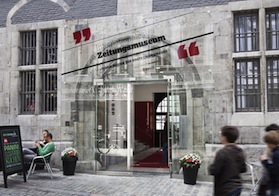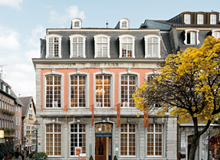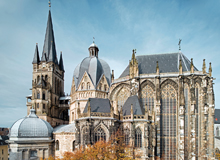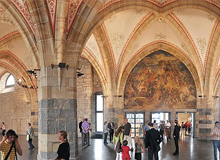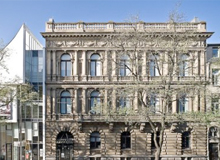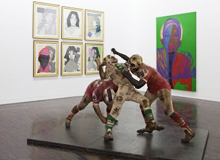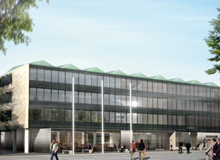Learning and Teaching
Daycare Centres and Schools
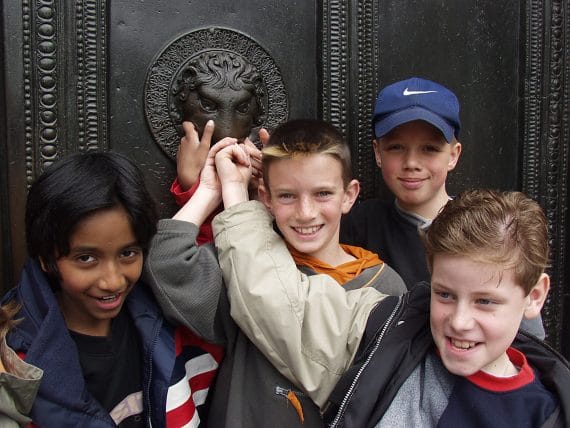
For more information and bookings:
Please contact
Museumsdienst Aachen
Johannes-Paul-II.-Straße 1
52058 Aachen
Tel.: +49 241 432-4998
museumsdienst@mail.aachen.de
www.museumsdienst-aachen.de
Centre Charlemagne – Aachen’s New City Museum
On around 800 sqm, the Centre Charlemagne guides you through the entire history of the city. One of the core themes of the exhibition is the story and legend of Charlemagne. The new permanent exhibition starts with early settlements at Aachen during the Neolithic Age and introduces you to Roman Aachen, the Carolingian Palace City and Aachen as an imperial coronation city during the Middle Ages. It then shows you Aachen’s history as a fashionable spa town during the Baroque, as an industrial border town during the modern age and the two world wars as well as its development to become the diverse European city it is today.
History Lab
At the History Lab at the inner triangle of the exhibition, students of any age can discover life in Carolingian Aachen around 800 CE on 180 sqm as well as the methods and contents of archaeological research.They can also handle objects from the Wardrobe, Overseas Trade, Armoury, Scriptorium and Pantry sections themselves. Using our touch monitors, you can learn about weaving from maid Puella, about the goods on sale from trader Freso, about armoury from Count Hunfried, about the monastery’s scriptorium from the young monk, Florentius, and about the food people ate from farmers Kuno and Emma.
Who is this for?
Our learning activities are aimed at preschools, special schools as well as primary and all secondary schools.
What do we offer?
• Guided tours through the permanent exhibition, including the History Lab (60 mins, no more than 20 students)
• Guided tours with hand puppets for daycare centres and primary schools
• Guided tours including a session of artistic/creative work at the Museum Workshop (90, 120 or 180 minutes in total)
• Individually arranged project days/weeks
• We are glad to design special activities upon your request.
Fee:
€20 guided tour (60 minutes) / €3-4 per student per hour at the Workshop / free admission for schools located in the Euregio
‘Museum in a Suitcase‘ Programme (History on the road – Charlemagne visiting you)
for daycare centres, classes 1-6
Two of us will meet your class, bringing our special suitcase, to travel back in time to the Middle Ages. At the time, Charlemagne was a powerful ruler and he is still famous today. The items we bring in the suitcase tell stories about life at the time of Emperor Charlemagne, the work archaeologists do and what is so fascinating about their discoveries. The suitcase contains a selection of carefully presented materials introducing students to Charlemagne, the Early Middle Ages and Archaeology in the city. We use different items and materials to provide a general understanding of different topics. The objects allow students to investigate and discover the Early Middle Ages themselves, to experience the items with all their senses, taking a closer look, touching, smelling and trying them. We will create something together, e.g. a large poster of the Palace area with little figurines to represent people, or a board game.
The programme covers two lessons (90 minutes) and can be easily integrated into the regular timetable. We will provide the arts and crafts supplies required.
This programme can be used to prepare for an actual visit to the museum, but can also be booked individually.
Fee: €150
Activities for preschool students and older
Charlemagne’s Stories – for curious pre-schoolers
A long time ago, Charlemagne was a powerful ruler and he is still famous today. Our tour around the exhibition will take us back in time to the Early Middle Ages, and we will hear stories about the life of
the great Charlemagne. Afterwards, we will create something together at the Museum Workshop (topic
to be agreed).
Off we go to the Middle Ages! – for curious pre-schoolers
How did people live in Aachen around 800 CE? At the History Lab, curious pre-schoolers can learn about
daily life 1200 years ago. What clothes were people wearing? What did a
mail shirt look like? What did people cook? How did people create beautiful handwritten documents? What could you buy at the market? Afterwards, we will create something together at the Museum Workshop (topic to be agreed).
Programmes for primary schools (6/7 years of age and older)
The Aachen Palace
Charlemagne was constantly travelling and truly ruled his empire ‘from horseback’. Up to a thousand people including his retinue and family accompanied him on his travels. He would be staying at one of his
countless palaces, known as ‘Pfalz’ in German. What did the Aachen Palace look like? How was it built? What other, similar palaces had been built before? What did the palace buildings include? Where did all the food needed for so many people come from, and who made sure that everything was ready for the ruler’s arrival? And how do we know all this? At the Museum Workshop, class can then design a big poster of the palace together.
On the road
During the Early Middle Ages, people travelled a lot less than they do today. Rulers travelled with their retinue and army. Pilgrims, traders, diplomats and craftsmen travelled, too. The one thing they had in common was that they were travelling across rough terrain; travelling was a cumbersome and dangerous undertaking. Where did people stay for the night? What modes of transport did they use? What would they take with them on their travels? How
could they get hold of food while travelling? Afterwards, students can create their own
travel rolls, coins or money pouches.
Long live the King!
Throughout the Middle Ages and until the early modern period, coronations of kings and emperors were important events. The most powerful people of the realm would be invited and everyone in the city would be celebrating. One important aspect of the coronation was the procession, which would be following the king throughout the ceremony. Afterwards, we will create something together at the Museum Workshop (topic to be agreed). What would it be like if class were allowed to take part in a coronation? What clothes would students be wearing? We will be building rod puppets and design them using fabric and colours.
Like a fish in water – Aachen’s traditional baths
Aachen has enjoyed a long-standing tradition as a spa town. Even the Romans used the hot springs and Charlemagne loved to have a bath with his family and guests. After the great fire of 1656, the city was rebuilt, which transformed Aachen into a modern spa town. Even today,
water fountains are the main feature of Aachen’s cityscape. After the tour, students will be able to design bathing products or mosaic floors of a bath.
Programmes for primary schools (8/9 years of age and older)
Outside the city gates…
Like many other cities, Aachen was surrounded by double city walls for protection during the Middle Ages. The inner city wall was constructed in 1172, while the outer city wall was built from around 1300. Originally, there were several city gates, but only two, the Marschiertor and Ponttor have been preserved until today. After
the tour, the students will be able to make city gates from clay at the Museum Workshop.
Copycats welcome!
Today, being able to write goes without saying.Emails and text messages allow us to communicate at cyber speed. But in Charlemagne’s days, only very few people had mastered the
art of reading and writing. Charlemagne had introduced the Carolingian
minuscule, a largely simplified script, which made writing a lot easier, but writing was a tiresome task nonetheless. After the tour, students will be able to try writing with quill pens and ink themselves.
For more information and bookings:
Please contact
Museumsdienst Aachen
Johannes-Paul-II.-Straße 1
52058 Aachen
Tel.: +49 241 432-4998
museumsdienst@mail.aachen.de
www.museumsdienst-aachen.de
Activities for primary school intensive German classes
Sounds of the City
We will investigate the soundscape of the Middle Ages and think about which of these sounds we can still hear today. We will then experiment further using our ‘Sound Suitcase’. Afterwards, we will design a ‘Sound Trail’ across the Imperial Palace at Aachen using a big poster. As this programme brings together watching, touching, listening, speaking and creative design, students of German will be offered a wide range of approaches and learning opportunities.
Activities for Secondary Schools (students aged 9/10 and older)
All up to the boss? Rulers of the Early Middle Ages
What does it mean to be powerful and to rule? How did rulers in Charlemagne’s days exercise their rule? Originally simply called Charles, he was given the title Charlemagne, or Charles the Great, already during his lifetime. His realm included large parts of what today is Europe. At the height of his power, he was crowned emperor by the Pope in Rome and in the eyes of his contemporaries became a successor to Roman rulers that way. What
was his power based on? How could he rule such a large empire at a time when there were no modern means of communication and transport? How did he display his claim to power and how much power was in the hands of the Church? After the tour, students will be able to design the CV of a ruler, a billboard or contemporary insignia to illustrate a ruler’s powers.
Life and Legend
Charlemagne was the most powerful emperor of the Early Middle Ages and had a decisive and long-lasting impact on culture, religion and society. Immediately after his burial,
legends surrounding Charlemagne began to flourish. This is owed much to Charlemagne’s biographer Einhard, who had started to create the ‘Charlemagne legend’ even before Charlemagne’s death. While for many centuries, most interpretations of Charlemagne’s life primarily saw him as a saint, he is now seen and discussed as the Father of Europe, ‘pater Europae’. After the tour, students will be able to discover what role Charlemagne plays for Europe today. Ruthless politician, despot, saint, founding father of Europe, idol, superstar of the Early Middle Ages, an important
person of days long gone?
Scriptorium
In Charlemagne’s days, only very few people knew how to read and write. There were different
scripts, many of which were quite difficult to decipher. Charlemagne had a very legible unified script developed that was used across his realm. Block letters we use today are based on the
‘Carolingian minuscules’. Thanks to what’s now known as the Carolingian Renaissance, reading and
writing once again gained in importance. Monasteries collected the texts of Ancient Roman and Greek authors to copy them and adorn them to the most meticulous detail. After the tour, students will be able to try writing Carolingian
minuscules using a wax tablet and stylus/quill pen and ink.
In the Spotlight: Archaeology – Carolingian Aachen
What can we learn about the
history of our city from shards, stones, bones or oyster shells we have found during excavations? What impact do these findings have on historiography? How do archaeologists work? What methods and tools do they use? What is experimental archaeology? After the tour, we offer students an opportunity to practice what they have learnt and debate recent findings.
The Museum as a Cultural Space
This tour presents the basic concepts and items on display at the Centre Charlemagne. What is the purpose of the museum as a
‘cultural space’ and why has this new museum on Aachen’s history been established? If I could create my own museum, what would it look like? Afterwards, we will construct relief or
three-dimensional architectural cardboard models. This allows students to reinvent their very own museum space. Individual sections can then be covered with monochrome photocopies of items on display as well as pictures of Aachen as a collage and then be painted.
DIY Urban History
In groups, students decide which items to include in the permanent exhibition. They will be given lists of items, work sheets and additional information. Students will be given key questions on which to focus in their deliberations on how to describe the individual items. During the tour following this, students will present their findings. A member of our educational staff will accompany the students to provide additional knowledge and information the students might need. Sample questions include: Which document turned Aachen into a flourishing imperial city in the post-Carolingian era? What had the greatest impact on daily life in the High Medieval Period? What role do the coronation procession and the Aachen Pilgrimage Shrine of Mary play for the presentation of the items?
Theatre Workshop (4-5 lessons or one project day)
Crowned Heads
The medieval coronation procession was a sensational event for the people of Aachen. Students will be able to experience this event themselves, playing different roles and designing their own costumes. Finally, we will re-enact the coronation procession around the Centre Charlemagne.
This workshop covers 4 to 5 lessons and is particularly suitable for project days.
Last update November 2015
Further activities in preparation.
We would like to kindly ask you to please book any activity at least a fortnight in advance.
For more information and bookings:
Please contact
Museumsdienst Aachen
Johannes-Paul-II.-Straße 1
52058 Aachen
Tel.: +49 241 432-4998
museumsdienst@mail.aachen.de
www.museumsdienst-aachen.de
